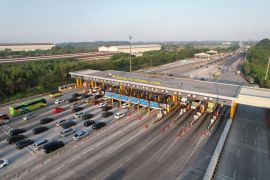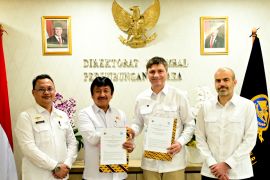The bridge will significantly cut travel time between the islands, which currently takes several hours by ferry. Some 20 million people crossed the strait in 2006, and this figure is predicted to double by 2020.
The bridge will be 75 meters high, to enable ships to pass under it, and will be constructed over three small islands in the strait - Prajurit, Ular and Sangiang. It is expected to cost about Rp100 trillion (or over US$11 billion). The bridge will be 60 meters wide and have three lanes for roads as well as railway tracks.
It will be the longest suspension bridge in the world, said Dedy S Priatnasahid, the Deputy Minister of National Development Planning in charge of facilities and infrastructures and the National Development Planning Board (Bappenas) on Wednesday (May 9).
"The government plans to unfurl the inaugural flag of the Sunda Strait Bridge in 2014," he added.
The Sunda Strait Bridge project will include the construction of highways, railroads and the development of communities near the mega-project.
The government has supported the project by issuing building concessions in Banten province (western Java Island) and Lampung (southern Sumatra Island). Following an agreement with the government, Bappenas will conduct an open tender after sending tender offers to several countries like China.
The Coordinating Minister for Economic Affairs Hatta Rajasa recently stated that the government remains committed to the mega-project and has issued a presidential decree for starting the bridge construction in 2014.
The government has allocated 40,000 hectares of land for the mega-project. The integrated area, according to the minister, covers 20,000 hectares in Banten, while the rest of the land is in Lampung to support the development of industrial areas after the bridge has become a reality.
After the issuance of the presidential decree (Kepres) on the construction of the Sunda Strait Bridge, the government plans to confirm the commitments of companies, including private companies and state-owned business enterprises (BUMN), which will together realize the mega-project.
Currently, the mega-project is awaiting a feasibility study, which will take into account the basic design of the bridge.
Earlier this year, Public Works Minister Djoko Kirmanto had claimed that the feasibility study on the bridge construction will take two years. The study will also consider the development of an industrial zone around the Sunda Strait Bridge area.
"In line with Presidential Instruction no. 86/2011 on Sunda Strait Strategic Area and Infrastructure Development (BUKSISS ), the initiators will soon conduct a feasibility study; they will be given 24 months to complete it," the minister had announced at a meeting on the Sunda Strait Bridge project in January 2012.
For this purpose, in the near future, the government and the Banten-Lampung consortium, in conjunction with PT Bangungraha Sejahtera Mulia, will together carry out a feasibility study for the bridge, with particular reference to its basic design and budget planning, he added.
According to the minister, the consortium joining the Artha Graha group , as one of the initiators of the mega-project, will take part in the tender with special privilege, for instance, the group will be able to choose one among the 10 percent preferences or have the right to match with one of them.
"We have had 11 or 12 meetings with experts from Japan and South Korea, and held discussions and seminars on this matter, and we have concluded that the construction of the bridge is feasible technically," he remarked.
It normally takes around 10 years to complete a construction project the size of the Sunda Strait Bridge, according to Wiratman Wangsadinata, a planning consultant for the project.
The bridge will be connected to the Jakarta-Merak toll road, the planned 14-km-long Cilegon-Ciwandan toll road and the planned 80-km-long Bakauheni-Bandar Lampung-Metro toll road.
The bridge will be earthquake-proof and is expected to last for 200 years.
Wiratman added that the design of the bridge`s upper structure will be similar to that of the Messina Strait Bridge in Italy, which has a span of 3,300 metres, while the design of its lower structure will resemble the Akashi Kaikyo Bridge in Japan, which has a span of 1,991 metres.
The Sunda Strait Bridge will have a deck similar to that of the Messina Strait Bridge, but with a shorter span.
The mega-project is expected to support government programs under Indonesia`s accelerated and expanded economic development master plan (MP3EI) by strengthening connectivity between corridors 1 (Sumatra) and 2 (Java).
According to Wiratman, the bridge will help boost the nation`s economic growth, create new job opportunities and reduce the poverty rate.
However, the president of the Graha Lampung Consortium in Banten Sejahtera, Agung R Prabowo, cautioned that many challenges will need to be overcome before the mega-project can be realized. These problems concern land clearance, technology, funding, politics and the environment. *
(f001/INE/H-YH)
Reporter: Fardah
Editor: Fardah Assegaf
Copyright © ANTARA 2012











